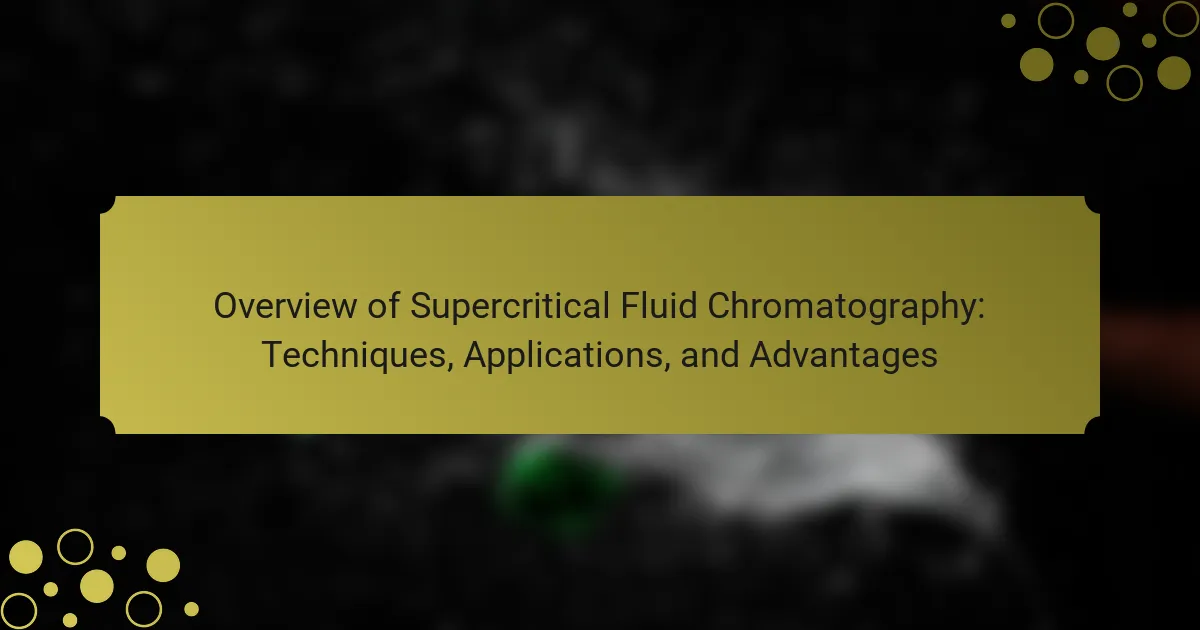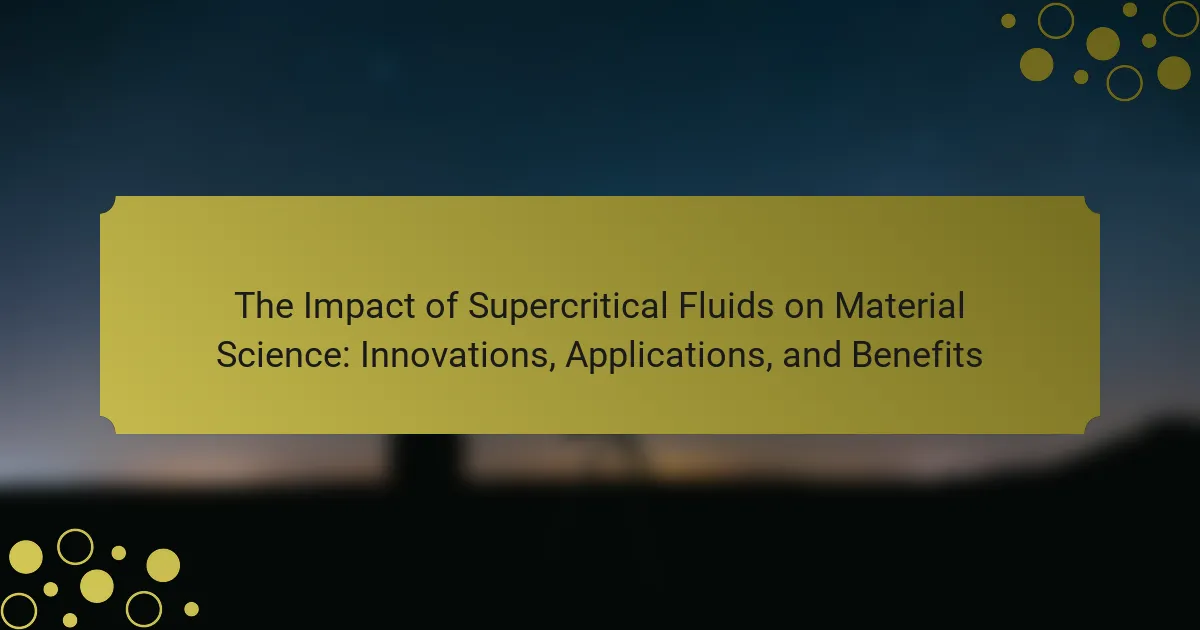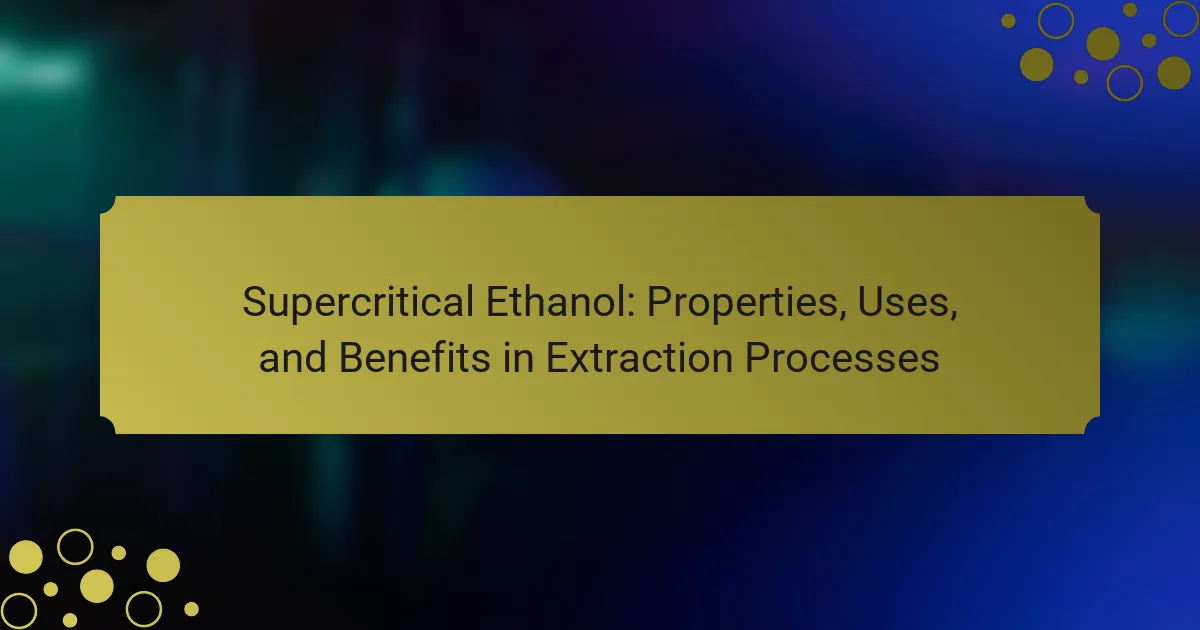Supercritical Fluid Drying (SFD) is a drying technique that employs supercritical fluids, primarily carbon dioxide, to effectively remove moisture from materials while preserving their quality. This process operates under elevated pressure and temperature, allowing the supercritical fluid to extract water without causing thermal degradation. SFD is particularly beneficial in food preservation, as it maintains the structural integrity, flavors, colors, and nutritional content of food products, while also reducing microbial growth and extending shelf life. The article will explore the techniques involved in SFD, its advantages over traditional drying methods, and its applications in enhancing the quality and appeal of dried foods. Additionally, it will outline the necessary equipment and conditions for successful implementation of this environmentally friendly drying process.

What is Supercritical Fluid Drying?
Supercritical Fluid Drying is a drying process that utilizes supercritical fluids, typically carbon dioxide, to remove moisture from materials. In this method, the supercritical fluid has properties of both liquid and gas, allowing for efficient moisture extraction. The process occurs at elevated pressure and temperature, creating an environment where the fluid can dissolve and carry away water. This technique is advantageous for preserving the quality and structure of sensitive materials, such as food products. Studies have shown that Supercritical Fluid Drying can minimize thermal degradation and maintain nutritional content. Research by S. A. K. H. Al-Harbi et al. in the “Journal of Food Engineering” highlights its effectiveness in food preservation.
How does Supercritical Fluid Drying work?
Supercritical Fluid Drying (SFD) works by utilizing supercritical fluids, typically carbon dioxide, to remove moisture from materials. In this process, the fluid is brought above its critical temperature and pressure, resulting in unique properties. The supercritical fluid can penetrate materials like a gas but dissolve substances like a liquid.
During SFD, the material is first saturated with the supercritical fluid. This saturation allows for efficient moisture extraction. As the pressure decreases, the supercritical fluid transitions to a gas, carrying away the moisture without forming a liquid phase. This helps maintain the material’s structure and prevents damage often associated with traditional drying methods.
Studies have shown that SFD can effectively preserve the quality of food products by minimizing thermal degradation. Research indicates that SFD reduces drying times and enhances the retention of bioactive compounds compared to conventional drying techniques.
What are the key principles behind Supercritical Fluid Drying?
Supercritical Fluid Drying (SFD) operates on the principle of using supercritical fluids, typically carbon dioxide, to remove moisture from materials. In SFD, the fluid exists above its critical temperature and pressure, exhibiting properties of both gas and liquid. This unique state allows for efficient mass transfer and reduced surface tension, minimizing damage to delicate structures. The process involves saturating the material with the supercritical fluid, followed by depressurization to facilitate drying. This method is advantageous because it avoids the thermal degradation often associated with conventional drying methods. Studies have shown that SFD can preserve the nutritional and sensory qualities of food products effectively.
What are the phases involved in the Supercritical Fluid Drying process?
The Supercritical Fluid Drying process involves three main phases: saturation, extraction, and drying. In the saturation phase, the material is immersed in a supercritical fluid, typically carbon dioxide, allowing the fluid to permeate the material. During the extraction phase, pressure is gradually reduced, causing the supercritical fluid to dissolve and remove moisture from the material. Finally, in the drying phase, the remaining supercritical fluid is eliminated through a further decrease in pressure or temperature, resulting in a dry product. This process effectively preserves the structure and quality of the material, making it suitable for applications in food preservation.
What are the advantages of Supercritical Fluid Drying?
Supercritical Fluid Drying (SFD) offers several advantages. It preserves the structure and integrity of heat-sensitive materials. SFD minimizes thermal degradation compared to conventional drying methods. The process uses supercritical fluids, typically carbon dioxide, which are non-toxic and environmentally friendly. SFD allows for rapid drying times due to high diffusivity in supercritical states. This technique can achieve low residual moisture content in dried products. Additionally, SFD results in products with better rehydration properties. Research shows that SFD can enhance the retention of bioactive compounds in food products. These advantages make SFD a valuable method in food preservation.
How does Supercritical Fluid Drying compare to traditional drying methods?
Supercritical Fluid Drying (SFD) offers advantages over traditional drying methods. SFD uses supercritical fluids, typically carbon dioxide, to remove moisture. This process preserves the structure and nutritional quality of food better than conventional drying. Traditional methods often involve high temperatures, leading to nutrient loss and texture degradation. SFD operates at lower temperatures, reducing thermal damage. Additionally, SFD allows for uniform drying, minimizing the risk of hotspots that can occur in traditional methods. Research indicates that SFD can retain up to 90% of the original nutrients in food, while traditional drying may result in significant nutrient loss. Thus, SFD is more effective for preserving food quality compared to traditional drying methods.
What specific benefits does Supercritical Fluid Drying provide for food preservation?
Supercritical Fluid Drying (SFD) provides several specific benefits for food preservation. It maintains the nutritional quality of food by minimizing the degradation of vitamins and other sensitive compounds. SFD reduces moisture content effectively, which inhibits microbial growth and extends shelf life. The process results in a more porous structure, enhancing rehydration properties. Additionally, SFD preserves the flavor and aroma of food better than traditional drying methods. Research indicates that SFD can retain up to 90% of volatile compounds in foods. This method also allows for the use of non-toxic solvents, making it environmentally friendly. Overall, SFD is an advanced technique that significantly improves food preservation outcomes.
What techniques are used in Supercritical Fluid Drying?
Supercritical Fluid Drying employs several techniques, primarily involving the use of supercritical carbon dioxide (CO2). One common technique is the pressure swing method, where pressure is alternated to facilitate the extraction of moisture. Another technique is the continuous flow method, which allows for a steady stream of supercritical fluid to remove water from the material. Additionally, batch processing is utilized for smaller quantities, enabling controlled drying conditions. These techniques enhance the preservation of sensitive food components while minimizing thermal degradation. Research indicates that supercritical fluid drying can retain up to 90% of volatile compounds in food products, confirming its effectiveness in food preservation.
What types of supercritical fluids are commonly used in drying?
Carbon dioxide and water are the two primary supercritical fluids commonly used in drying. Carbon dioxide is favored due to its low critical temperature and pressure, making it suitable for heat-sensitive materials. It is also non-toxic and readily available. Water, as a supercritical fluid, offers high solvent power for polar compounds. Both fluids effectively remove moisture while preserving the integrity of the dried material. The use of supercritical fluids minimizes thermal degradation, ensuring better quality in food preservation.
How do different techniques affect the outcome of Supercritical Fluid Drying?
Different techniques significantly influence the outcome of Supercritical Fluid Drying (SFD). Techniques such as pressure control, temperature variation, and solvent choice alter the drying rate and product quality. For instance, higher pressures typically lead to increased solubility of the drying solvent, enhancing moisture removal efficiency. Conversely, varying the temperature can affect the viscosity of the solvent, impacting the mass transfer rate. The choice of solvent also plays a crucial role; some solvents may interact better with specific materials, leading to improved drying outcomes. Studies have shown that optimizing these parameters can result in products with better texture and nutritional quality.
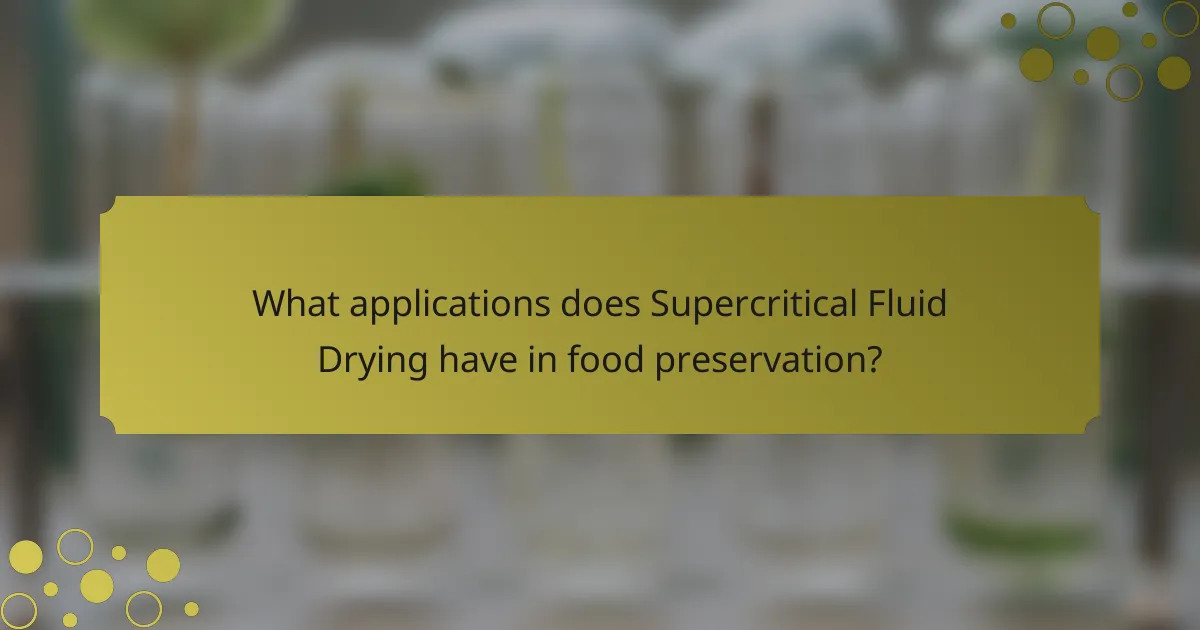
What applications does Supercritical Fluid Drying have in food preservation?
Supercritical Fluid Drying (SFD) is utilized in food preservation to enhance product quality and shelf life. SFD effectively removes moisture from food products while maintaining their structural integrity. This technique minimizes thermal degradation, preserving flavors, colors, and nutrients. SFD also reduces microbial growth, which extends the shelf life of food items. Additionally, it enables the production of lightweight and highly porous food products. Research indicates that SFD can improve the rehydration properties of dried foods, making them more appealing for consumption. Furthermore, SFD is environmentally friendly, using less energy compared to traditional drying methods.
How is Supercritical Fluid Drying utilized in the food industry?
Supercritical Fluid Drying (SFD) is utilized in the food industry to enhance preservation and maintain quality. SFD employs supercritical fluids, typically carbon dioxide, to remove moisture from food products. This method minimizes thermal degradation and preserves volatile compounds, flavors, and nutrients.
Research indicates that SFD can produce dried food products with better texture and rehydration properties compared to conventional drying methods. Studies show that SFD can reduce drying time significantly, improving energy efficiency. For example, a study published in the “Journal of Food Engineering” demonstrated that SFD achieved moisture removal in less than half the time of traditional drying techniques.
Overall, SFD offers a promising approach for producing high-quality dried food products while maintaining their nutritional value.
What types of food products benefit most from Supercritical Fluid Drying?
Fruits, vegetables, and sensitive food products benefit most from Supercritical Fluid Drying. This method preserves flavor, color, and nutrients effectively. It is particularly advantageous for products like berries, herbs, and spices. Supercritical Fluid Drying minimizes thermal damage during the drying process. This technique also enhances the shelf life of food products. Research shows that it retains more antioxidants compared to conventional drying methods. Studies indicate that dried fruits maintain their texture and taste better with this technique. Overall, Supercritical Fluid Drying is ideal for delicate food items requiring preservation of quality.
How does Supercritical Fluid Drying enhance food quality and shelf life?
Supercritical Fluid Drying enhances food quality and shelf life by preserving nutrients and preventing oxidation. This technique utilizes supercritical fluids, typically carbon dioxide, to remove moisture from food products. The process operates at low temperatures, which helps maintain the integrity of heat-sensitive compounds.
By avoiding high temperatures, Supercritical Fluid Drying retains essential vitamins and flavors that are often lost in conventional drying methods. Additionally, the method minimizes microbial growth due to reduced moisture content. Research indicates that food products dried using supercritical fluids exhibit longer shelf life compared to those dried through traditional methods.
For instance, studies show that dried fruits maintain higher antioxidant levels when processed with supercritical fluid techniques. This results in both improved nutritional value and extended storage periods.
What are the challenges associated with Supercritical Fluid Drying?
Supercritical Fluid Drying (SFD) faces several challenges. High operational costs are a significant barrier. The equipment required for SFD is expensive to purchase and maintain. Additionally, the process needs precise control of temperature and pressure. This requirement complicates the operational setup. Another challenge is the scalability of the technology. Many small-scale applications struggle to transition to larger production levels. Furthermore, the choice of solvent can impact the quality of the final product. Some solvents may react adversely with the material being dried. Finally, there is a lack of comprehensive research on long-term effects. This gap limits the understanding of SFD’s full potential in various applications.
What factors can affect the efficiency of Supercritical Fluid Drying?
The efficiency of Supercritical Fluid Drying (SFD) is influenced by several factors. These include temperature, pressure, and the type of solvent used. Higher temperatures can enhance the solubility of the drying agent. Pressure adjustments can optimize the fluid’s properties for better extraction. The choice of solvent affects the drying rate and efficiency. Additionally, the material’s characteristics, such as porosity and moisture content, play a crucial role. The drying time is also significant; longer durations can improve moisture removal. Studies indicate that optimal conditions can lead to reduced drying times and improved product quality.
How can common issues in Supercritical Fluid Drying be resolved?
Common issues in Supercritical Fluid Drying can be resolved by optimizing process parameters. Adjusting temperature and pressure can enhance solubility and extraction efficiency. Monitoring the flow rate of supercritical fluid is crucial for consistent results. Implementing proper equipment maintenance prevents blockages and ensures smooth operation. Utilizing suitable solvents increases drying efficiency and product quality. Employing real-time monitoring systems can detect anomalies during the process. Research shows that these adjustments lead to improved drying rates and product integrity. For instance, a study by R. D. P. de Oliveira et al. (2020) demonstrated that optimized conditions significantly reduced drying time and enhanced the quality of dried food products.
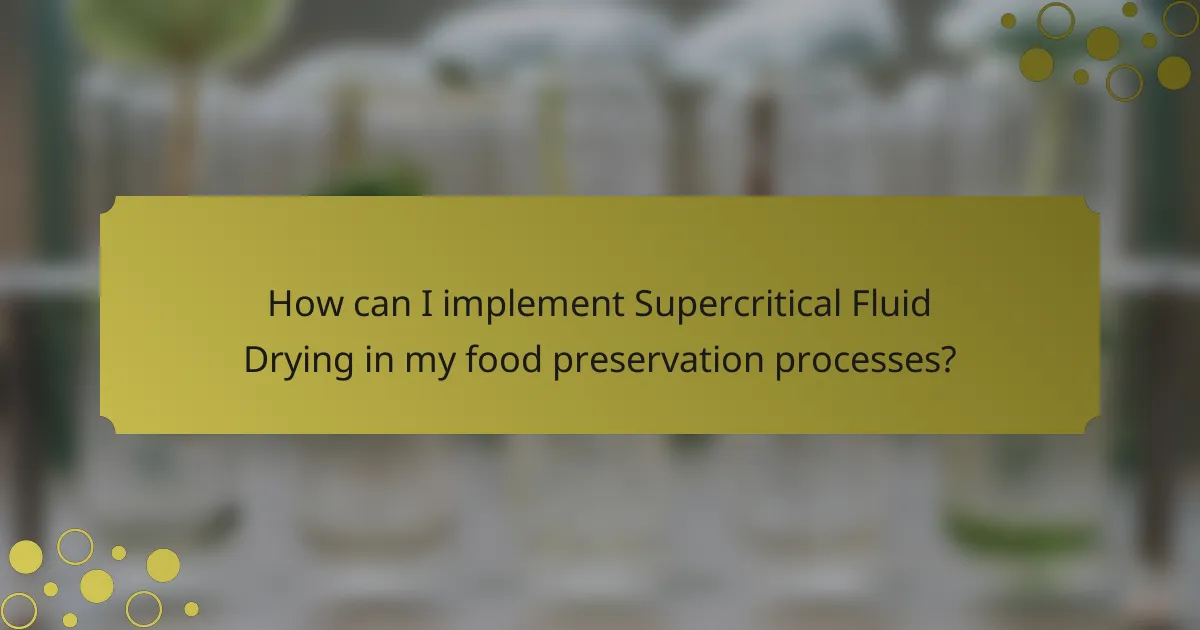
How can I implement Supercritical Fluid Drying in my food preservation processes?
To implement Supercritical Fluid Drying in food preservation processes, first acquire a supercritical fluid extractor. This equipment is essential for the process. Next, select an appropriate solvent, commonly carbon dioxide, for its effectiveness and safety. Prepare the food by cutting it into uniform pieces to ensure even drying. Control the pressure and temperature to reach the supercritical state of the solvent. Maintain the optimal conditions for the specific food type to ensure effective moisture removal. Monitor the process closely to prevent degradation of food quality. Research shows that supercritical fluid drying retains more nutrients compared to traditional methods, making it a beneficial choice for food preservation.
What best practices should be followed for effective Supercritical Fluid Drying?
Effective Supercritical Fluid Drying requires precise control of temperature and pressure. Maintaining optimal conditions ensures the supercritical fluid achieves the desired properties for drying. Use high-quality solvents to enhance extraction efficiency. Properly pre-treating materials can improve drying outcomes. Implement continuous monitoring of the drying process to identify deviations. Ensure adequate ventilation to remove residual solvents post-drying. Use appropriate equipment designed for supercritical fluid applications. Following these practices can significantly enhance the drying efficiency and product quality.
What equipment is necessary for Supercritical Fluid Drying?
Supercritical Fluid Drying requires several key pieces of equipment. A high-pressure vessel is essential to maintain supercritical conditions. This vessel must withstand high pressures and temperatures. A CO2 pump is necessary to achieve and maintain the required supercritical fluid pressure. Additionally, an extraction chamber allows the material to be dried effectively. A separator is needed to recover the supercritical fluid post-drying. Finally, a cooling system is important to manage the temperature during the process. These components work together to ensure efficient drying of materials using supercritical fluids.
How can I optimize the Supercritical Fluid Drying process for my specific needs?
To optimize the Supercritical Fluid Drying process for specific needs, adjust key parameters such as pressure, temperature, and solvent choice. Increasing pressure enhances the solubility of the drying agent, leading to improved moisture removal. Higher temperatures can accelerate drying rates but may affect product quality. Selecting the appropriate solvent, like carbon dioxide, ensures compatibility with the material being dried. Additionally, controlling the flow rate of the supercritical fluid can influence the efficiency of the drying process. Research indicates that fine-tuning these variables can lead to better preservation of food quality and nutritional content.
Supercritical Fluid Drying (SFD) is a drying technique that utilizes supercritical fluids, primarily carbon dioxide, to efficiently remove moisture from materials while preserving their quality. This article covers the principles and phases of SFD, highlighting its advantages over traditional drying methods, such as reduced thermal degradation and enhanced retention of nutrients and flavors in food products. Key techniques, applications, and best practices for implementing SFD in food preservation processes are discussed, along with the necessary equipment and factors influencing the efficiency of the process. Overall, SFD presents a promising approach for maintaining the integrity and extending the shelf life of sensitive food items.
